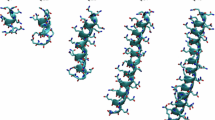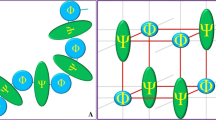Abstract
Polyglutamine (polyQ, a peptide) with an abnormal repeat length is the causative agent of polyQ diseases, such as Huntington’s disease. Although glutamine is a polar residue, polyQ peptides form insoluble aggregates in water, and the mechanism for this aggregation is still unclear. To elucidate the detailed mechanism for the nucleation and aggregation of polyQ peptides, replica exchange molecular dynamics simulations were performed for monomers and dimers of polyQ peptides with several chain lengths. Furthermore, to determine how the aggregation mechanism of polyQ differs from those of other peptides, we compared the results for polyQ with those of polyasparagine and polyleucine. The energy barrier between the monomeric and dimeric states of polyQ was found to be relatively low, and it was observed that polyQ dimers strongly favor the formation of antiparallel β-sheet structures. We also found a characteristic behavior of the monomeric polyQ peptide: a turn at the eighth residue is always present, even when the chain length is varied. We previously showed that a structure including more than two sets of β-turns is stable, so a long monomeric polyQ chain can act as an aggregation nucleus by forming several pairs of antiparallel β-sheet structures within a single chain. Since the aggregation of polyQ peptides has some features in common with an amyloid fibril, our results shed light on the mechanism for the aggregation of polyQ peptides as well as the mechanism for the formation of general amyloid fibrils, which cause the onset of amyloid diseases.












Similar content being viewed by others
Abbreviations
- Q:
-
Glutamine
- polyQ:
-
Polyglutamine
- MD:
-
Molecular dynamics
- REMD:
-
Replica exchange molecular dynamics
- MMD:
-
Multiple molecular dynamics
- CD:
-
Circular dichroism
- DPSS:
-
Dictionary of protein secondary structure
- apβ:
-
Antiparallel β-sheet
- pβ:
-
Parallel β-sheet
- D min :
-
The minimum distance between the Cα atoms of the monomers (except for both termini)
- Λ mono :
-
Distance from the Cα atom of the C-terminus to that of the N-terminus
- \( n_{\mathrm{Hbond}}^{\mathrm{inter}} \) :
-
The number of intermolecular hydrogen bonds between two molecules
References
The Huntington’s Disease Collaborative Research Group (1993) A novel gene containing a trinucleotide repeat that is expanded and unstable on Huntington’s disease chromosomes. Cell 72:971–983. doi:10.1016/0092-8674(93)90585-E
Rubinsztein DC, Leggo J, Coles R, Almqvist E, Biancalana V, Cassiman JJ, Chotai K, Connarty M, Crauford D, Curtis A, Curtis D, Davidson MJ, Differ AM, Dode C, Dodge A, Frontali M, Ranen NG, Stine OC, Sherr M, Abbott MH, Franz ML, Graham CA, Harper PS, Hedreen JC, Jackson A, Kaplan JC, Losekoot M, MacMillan JC, Morrison P, Trottier Y, Novelletto A, Simpson SA, Theilmann J, Whittaker JL, Folstein SE, Ross CA, Hayden MR (1996) Phenotypic characterization of individuals with 30–40 CAG repeats in the Huntington disease (HD) gene reveals HD cases with 36 repeats and apparently normal elderly individuals with 36–39 repeats. Am J Hum Genet 59:16–22
Chen S, Ferrone FA, Wetzel R (2002) Huntington’s disease age-of-onset linked to polyglutamine aggregation nucleation. Proc Natl Acad Sci USA 99:11884–11889. doi:10.1073/pnas.182276099
Cooper JK, Schilling G, Peters MF, Herring WJ, Sharp AH, Kaminsky Z, Masone J, Khan FA, Delanoy M, Borchelt DR, Dawson VL, Dawson TM, Ross CA (1998) Truncated N-terminal fragments of huntingtin with expanded glutamine repeats form nuclear and cytoplasmic aggregates in cell culture. Hum Mol Genet 7:783–790. doi:10.1093/hmg/7.5.783
Chen S, Berthelier V, Hamilton JB, O’Nuallain B, Wetzel R (2002) Amyloid-like features of polyglutamine aggregates and their assembly kinetics. Biochemistry 41:7391–7399. doi:10.1021/bi011772q
Scherzinger E, Lurz R, Turmaine M, Mangiarini L, Hollenbach B, Hasenbank R, Bates GP, Davies SW, Lehrach H, Wanker EE (1997) Huntingtin-encoded polyglutamine expansions form amyloid-like protein aggregates in vitro and in vivo. Cell 90:549–558. doi:10.1016/S0092-8674(00)80514-0
Hollenbach B, Scherzinger E, Schweiger K, Lurz R, Lehrach H, Wanker EE (1999) Aggregation of truncated GST-HD exon 1 fusion proteins containing normal range and expanded glutamine repeats. Philos Trans R Soc Lond B Biol Sci 354:991–994
Georgalis Y, Starikov EB, Hollenbach B, Lurz R, Scherzinger E, Saenger W, Lehrach H, Wanker EE (1998) Huntingtin aggregation monitored by dynamic light scattering. Proc Natl Acad Sci USA 95:6118–6121
Scherzinger E, Sittler A, Schweiger K, Heiser V, Lurz R, Hasenbank R, Bates GP, Lehrach H, Wanker EE (1999) Self-assembly of polyglutamine-containing huntingtin fragments into amyloid-like fibrils: implications for Huntington’s disease pathology. Proc Natl Acad Sci USA 96:4604–4609. doi:10.1073/pnas.96.8.4604
Perutz MF, Johnson T, Suzuki M, Finch JT (1994) Glutamine repeats as polar zippers: their possible role in inherited neurodegenerative diseases. Proc Natl Acad Sci USA 91:5355–5358
Sharma D, Sharma S, Pasha S, Brahmachari SK (1999) Peptide models for inherited neurodegenerative disorders: conformation and aggregation properties of long polyglutamine peptides with and without interruptions. FEBS Lett 456:181–185. doi:10.1016/S0014-5793(99)00933-3
Tanaka M, Morishima I, Akagi T, Hashikawa T, Nukina N (2001) Intra- and intermolecular beta-pleated sheet formation in glutamine-repeat inserted myoglobin as a model for polyglutamine diseases. J Biol Chem 276:45470–45475. doi:10.1074/jbc.M107502200
Bevivino AE, Loll PJ (2001) An expanded glutamine repeat destabilizes native ataxin-3 structure and mediates formation of parallel beta-fibrils. Proc Natl Acad Sci USA 98:11955–11960. doi:10.1073/pnas.211305198
Sharma D, Shinchuk LM, Inouye H, Wetzel R, Kirschner DA (2005) Polyglutamine homopolymers having 8–45 residues form slablike beta-crystallite assemblies. Proteins 61:398–411. doi:10.1002/prot.20602
Vitalis A, Wang X, Pappu RV (2008) Atomistic simulations of the effects of polyglutamine chain length and solvent quality on conformational equilibria and spontaneous homodimerization. J Mol Biol 384:279–297. doi:10.1016/j.jmb.2008.09.026
Crick SL, Jayaraman M, Frieden C, Wetzel R, Pappu RV (2006) Fluorescence correlation spectroscopy shows that monomeric polyglutamine molecules form collapsed structures in aqueous solutions. Proc Natl Acad Sci USA 103:16764–16769. doi:10.1073/pnas.0608175103
Masino L, Kelly G, Leonard K, Trottier Y, Pastore A (2002) Solution structure of polyglutamine tracts in GST-polyglutamine fusion proteins. FEBS Lett 513:267–272. doi:10.1016/S0014-5793(02)02335-9
Nakano M, Watanabe H, Rothstein SM, Tanaka S (2010) Comparative characterization of short monomeric polyglutamine peptides by replica exchange molecular dynamics simulation. J Phys Chem B 114:7056–7061. doi:10.1021/jp9122024
Wang Y, Voth GA (2010) Molecular dynamics simulations of polyglutamine aggregation using solvent-free multiscale coarse-grained models. J Phys Chem B 114:8735–8743. doi:10.1021/jp1007768
Laghaei R, Mousseau N (2010) Spontaneous formation of polyglutamine nanotubes with molecular dynamics simulations. J Chem Phys 132:165102. doi:10.1063/1.3383244
Lakhani VV, Ding F, Dokholyan NV (2010) Polyglutamine induced misfolding of huntingtin exon1 is modulated by the flanking sequences. PLoS Comput Biol 6:e1000772. doi:10.1371/journal.pcbi.1000772
Sugita Y, Okamoto Y (1999) Replica-exchange molecular dynamics method for protein folding. Chem Phys Lett 314:141–151. doi:10.1016/S0009-2614(99)01123-9
Caves LS, Evanseck JD, Karplus M (1998) Locally accessible conformations of proteins: multiple molecular dynamics simulations of crambin. Protein Sci 7:649–666
Straub JE, Rashkin AB, Thirumalai D (1994) Dynamics in rugged energy landscapes with applications to the S-peptide and ribonuclease A. J Am Chem Soc 116:2049–2063. doi:10.1021/ja00084a051
Elofsson A, Nilsson L (1993) How consistent are molecular dynamics simulations? Comparing structure and dynamics in reduced and oxidized Escherichia coli thioredoxin. J Mol Biol 233:766–780. doi:10.1006/jmbi.1993.1551
Case DA, Darden TA, Cheatham TE III, Simmerling CL, Wang J, Duke RE, Luo R, Crowley M, Walker RC, Zhang W, Merz KM, Wang B, Hayik S, Roitberg A, Seabra G, Kolossvary I, Wong KF, Paesani F, Vanicek J, Wu X, Brozell SR, Steinbrecher T, Gohlke H, Yang L, Tan C, Mongan J, Hornak V, Cui G, Mathews DH, Seetin MG, Sagui C, Babin V, Kollman PA (2008) AMBER 10. University of California San Francisco, San Francisco
Onufriev A, Bashford D, Case DA (2004) Exploring protein native states and large-scale conformational changes with a modified generalized born model. Proteins 55:383–394. doi:10.1002/prot.20033
Zhou R (2003) Free energy landscape of protein folding in water: explicit vs. implicit solvent. Proteins 53:148–161. doi:10.1002/prot.10483
Shell MS, Ritterson R, Dill KA (2008) A test on peptide stability of AMBER force fields with implicit solvation. J Phys Chem B 112:6878–6886. doi:10.1021/jp800282x
Gnanakaran S, Nymeyer H, Portman J, Sanbonmatsu KY, García AE (2003) Peptide folding simulations. Curr Opin Struct Biol 13:168–174. doi:10.1016/S0959-440X(03)00040-X
Schneider T, Stoll E (1978) Molecular-dynamics study of a three-dimensional one-component model for distortive phase transitions. Phys Rev B 17:1302–1322. doi:10.1103/PhysRevB.17.1302
Pastor RW, Brooks BR, Szabo A (1988) An analysis of the accuracy of Langevin and molecular dynamics algorithms. Mol Phys 65:1409–1419. doi:10.1080/00268978800101881
Kabsch W, Sander C (1983) Dictionary of protein secondary structure: pattern recognition of hydrogen-bonded and geometrical features. Biopolymers 22:2577–2637. doi:10.1002/bip.360221211
Nakanishi K, Kikuchi M (2006) Thermodynamics of aggregation of two proteins. JPSJ 75:64803–64806. doi:10.1143/JPSJ.75.064803
Nagai Y, Inui T, Popiel HA, Fujikake N, Hasegawa K, Urade Y, Goto Y, Naiki H, Toda T (2007) A toxic monomeric conformer of the polyglutamine protein. Nat Struct Mol Biol 14:332–340. doi:10.1038/nsmb1215
Thakur AK, Wetzel R (2002) Mutational analysis of the structural organization of polyglutamine aggregates. Proc Natl Acad Sci USA 99:17014–17019. doi:10.1073/pnas.252523899
Nakano M (2010) Doctoral thesis. Kobe University, Kobe Japan
DeLano Scientific LLC (2006) PyMOL viewer v0.99. DeLano Scientific LLC, Palo Alto
Acknowledgments
We thank Dr. Takatoshi Fujita for useful comments and discussions. The numerical calculations were partially carried out on a PC-cluster system in the Cybermedia Center at Osaka University.
Author information
Authors and Affiliations
Corresponding authors
Rights and permissions
About this article
Cite this article
Nakano, M., Ebina, K. & Tanaka, S. Study of the aggregation mechanism of polyglutamine peptides using replica exchange molecular dynamics simulations. J Mol Model 19, 1627–1639 (2013). https://doi.org/10.1007/s00894-012-1712-9
Received:
Accepted:
Published:
Issue Date:
DOI: https://doi.org/10.1007/s00894-012-1712-9




